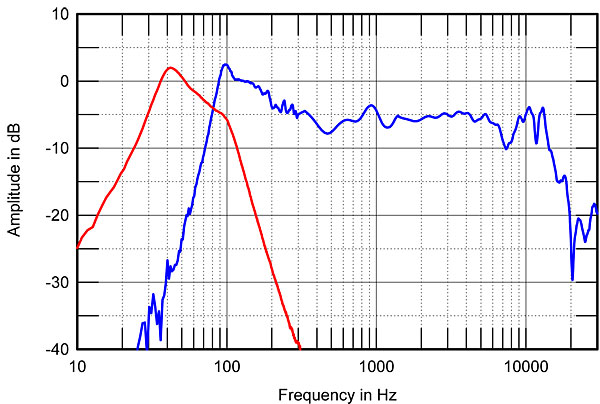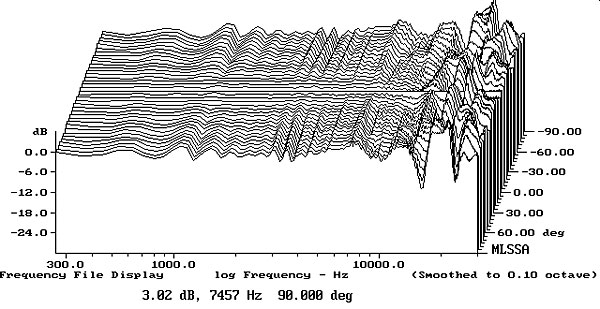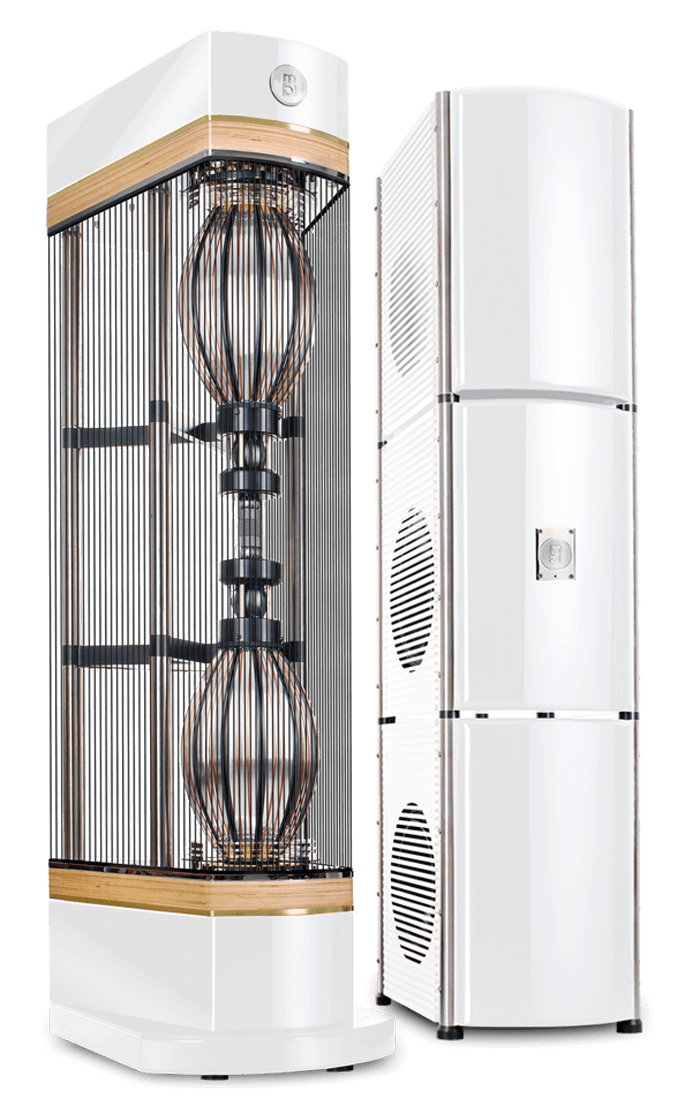| Columns Retired Columns & Blogs |
In my humble opinion, I have never heard a more 'perfect' loudspeaker than the MBL 101's. The 111's are no slouch either.
Great review Michael.
I used DRA Labs' MLSSA system and a calibrated DPA 4006 microphone to measure the MBL Radialstrahler 101E Mk.II's frequency response in the farfield, and an Earthworks QTC-40 for the nearfield and spatially averaged room responses. Because of its bulk, I measured the speaker (serial no.233831) in Michael Fremer's driveway; though we raised it as far as practicable, the inevitable reflection of the speaker's sound from the ground affects the resolution of the measured response in the midrange. The axis chosen for the farfield measurements was level with the center of the upper-midrange unit's vertical "petals," 45" from the bottom of the speaker and below the tweeter, which sits atop the upper-midrange magnet. (This is what I understood to be the optimal axis.) The shorting plugs on the rear terminal panel were set to HF Natural, MF Natural, and LF Attack, which was how MF had listened to the speakers.
The Mk.II version of the 101E has a specified sensitivity of 82dB/2.83V/m; my estimate was slightly lower than this, at 81dB(B), which is very low. However, because of its omnidirectional nature, the MBL will seem louder than this in a room of typical size. Despite the changes to the crossover and woofer section, the electrical impedance of the 101E Mk.II (fig.1) is very similar to that of the original version (see fig.1). The lowest magnitude now occurs in the midbass rather than the middle of the midrange—3.3 ohms at 41Hz—but the speaker will still demand a good, high-powered amplifier rated at 4 ohms to give of its best, especially as there is a current-hungry combination of 3.8 ohms and –51° electrical phase angle at 37Hz.

The impedance traces were free from the wrinkles that would indicate the presence of cabinet resonances, and I could find none of significance in the bandpass enclosure (not shown). As I explained in our October 2004 review of the original version of this speaker, the output of a bandpass enclosure resembles that of the port of a traditional reflex design, but with symmetrical 12dB/octave rolloffs above and below its passband. This can be seen in the nearfield response of one of the ports (fig.2, red trace): Though the low-pass rolloff is initially less than 12dB/octave, it is then steepened by the crossover filter to what appears to be 18dB/octave. The ports' limited passband is associated with a less well-defined time-domain output, so setting the correct level of the bandpass section is tricky for the system's designer.

Higher in frequency in fig.2, the nearfield response of the aluminum-petal lower-midrange unit (blue trace below 300Hz) peaks up a little more than I was anticipating, though this will be partly due to the nearfield measurement technique. It might also stem from the fact that I had to measure the speaker outdoors, and the temperature was around 55°F (13°C), which might have stiffened the suspension of the petals. This unit rolls off with a fast, 24dB/octave filter slope. The 101E Mk.II is remarkably flat throughout the midrange and treble, and this version of the speaker is less peaky in the top octave than the original, though it does roll off quickly above 14kHz. I doubt that listeners will find this a problem. This response was taken with the HF control set to Natural; the Attack setting brings up the top octave by about 2dB at 15kHz.
The 101E Mk.II's plot of lateral dispersion (fig.3) indicates that the speaker is indeed a true omnidirectional design. Though the radiation pattern is disturbed a little by the inevitable reflections, there is as much energy radiated to the sides in this graph as there is to the speaker's front. The MBL's vertical dispersion (fig.4) is even over quite a wide angle, suggesting that the 101E Mk.II is unfussy regarding listening axis, which is what you'd expect from the use of fourth-order Linkwitz-Riley filters in the crossover.


The somewhat complicated-looking traces in fig.5 show three spatially averaged responses: the response of the Radialstrahler 101E Mk.IIs in Michael Fremer's listening room, as initially set up by him (blue trace) and then by MBL North America's Jeremy Bryan (red); and the response of Mikey's reference Wilson MAXX 3s (green). You can see that Bryan's fine-tuning brought up the MBLs' 90–150Hz region to give a better blend with the outputs above and below that region, while leaving the midrange and treble regions untouched and with slight depressions balanced by slight plateaus. Bryan also reduced the height of the peak centered on the output of the bandpass section by a dB or so, but I suspect that the MBL's port output coincides with the frequency of a resonant mode in Michael's room, as the peak's level remains exaggerated. As MF noted, although his room is not small, the MBLs really require either a larger room than his, or one in which they can be moved farther away from the room boundaries, to get the smoothest low-frequency performance.

The Wilsons, too, suffer from an exaggerated midbass response in Michael's room, though not to the same degree as the MBLs. However, the faster reflex rolloff of the MAXX 3s results in less output below 30Hz. The Wilsons have less good integration between their upper bass and lower midrange than the MBLs, but their midrange and treble balance is smoother overall, with a touch less mid-treble energy.
As with the original version of the 101E, the Mk.II's step response (fig.6) suggests that all of its drive-units are connected in positive acoustic polarity, with the output of the tweeter arriving first at the microphone, followed by the outputs of the upper-midrange unit, then the lower-midrange unit, and, finally, the bandpass ports. The decay of each unit's step blends smoothly with the start of that of the unit next lower in frequency, correlating with the excellent blending of their outputs seen in the frequency domain (fig.1). Early reflections of the drive-unit outputs can be seen just after the 6 millisecond line in fig.6, these reflections coming from the magnet structures and the horizontal styling plates under the lower-midrange "melon." As a result, I had to aggressively window the impulse-response data when I prepared the MBL's cumulative spectral-decay plot (fig.7), which resulted in a dotted region where the data are invalid. I suspect that the rather hashy-looking decay of the speaker's output in this graph is due to even earlier reflections than to the storage and delayed release of energy, but the strong resonant ridge at 14kHz in the original version's cumulative spectral-decay plot (fig.8) is absent.


As I said of the original MBL Radialstrahler 101E, this is an intriguing design that works as advertised, providing truly omnidirectional performance at all frequencies. But to ensure smooth, extended bass, that bandpass low-frequency section requires care in setup and a room of optimal size, something about which the MBL dealer will be able to advise.—John Atkinson

In my humble opinion, I have never heard a more 'perfect' loudspeaker than the MBL 101's. The 111's are no slouch either.
Great review Michael.

It would have been helpful to me if you had included your listening room size as a referent given the importance placed on listening room size in the review.
IIRC, Mikey's room is approximately 25' by 18' by 8'.
John Atkinson
Editor, Stereophile

The MBL 101E MK II and it's big brother the X-Treme comes closer than any other speakers I can think of to bringing the live performance to the listener. The power, scale, and effortless, room-filling sound really transport the listener to the artist. It cannot be emphasized enough how these speakers can convey the emotion of music.
I heard them at AXPONA last year and at CES this year. Each time it is really an experience. I can't wait to hear the them again at the New York AV show.

Hello Michael.
Can you give your thoughts on whether or not a higher measured efficiency rating for the 101E Mk IIs would improve the sound/performance? Is it even possible to appreciably increase efficiency with this type of design? I am in the "High Efficiency" camp for speakers, for the most part, and find the very low 81 dB(B) measured spec of the MBLs to be somewhat of a turn-off for me. I'm trying to imagine how this speaker would perform if it had a sensitivity rating of 90 dB or higher.
Thanks, and take care.
Allen

they can change the efficiency rating of those speakers. They are what they are, just like planer speakers typically have low efficiency ratings as well. it's the nature of the way the drivers are designed with their stave design. It's more of a matter of what type of power you need to drive them more than sound quality. That's why MBL has relatively high wattage power amps to drive them and the amps have to be of decent quality, which unfortunately are typically more expensive.
MBL would have to use traditional cone drivers to get something in the 90dB efficiency level, but as you can see, they only use traditional cone drivers for their subwoofers and not their other drivers.

drblank commented, "...as you can see, they only use traditional cone drivers for their subwoofers and not their other drivers."
Each of these loudspeakers includes a single twelve inch woofer in bandpass alignment in the lower enclosure. There are no separate subwoofers in the system under review.
The larger and much more expensive MBL 101 X-Treme MKII Radialstrahler System (half of it shown below) includes a pair of separate subwoofers, each is six feet tall with six twelve inch woofers, for a full dozen twelve inch woofers in total. And it does not use bandpass alignment on the woofers, as you can see.


Snatch them up while you can!

Despite Fremer's foray into cable silliness, this was a well written, hard hitting review. The speaker's unique design and the few aspects that were measured beckon for more detailed measurements. I suspect that distortion measurements conducted at different drive levels would be more revealing of the significant challenges posed by the design of the drivers in this speaker.
Stereophile should also be putting more of its limited financial resources into supplying ancillary equipment to support reviews like this. Instead of flying more "journalists" to the next social gathering trade show, why not invest in a few hundred square feet of room treatment panels to outfit the listening room of a reviewer who intends to audition a pair of omnidirectional speakers? This exercise was a little like test driving a Bugatti Veyron in a Piggly Wiggly parking lot full of aging Floridians pushing their Ensure and Depends laden shopping carts...